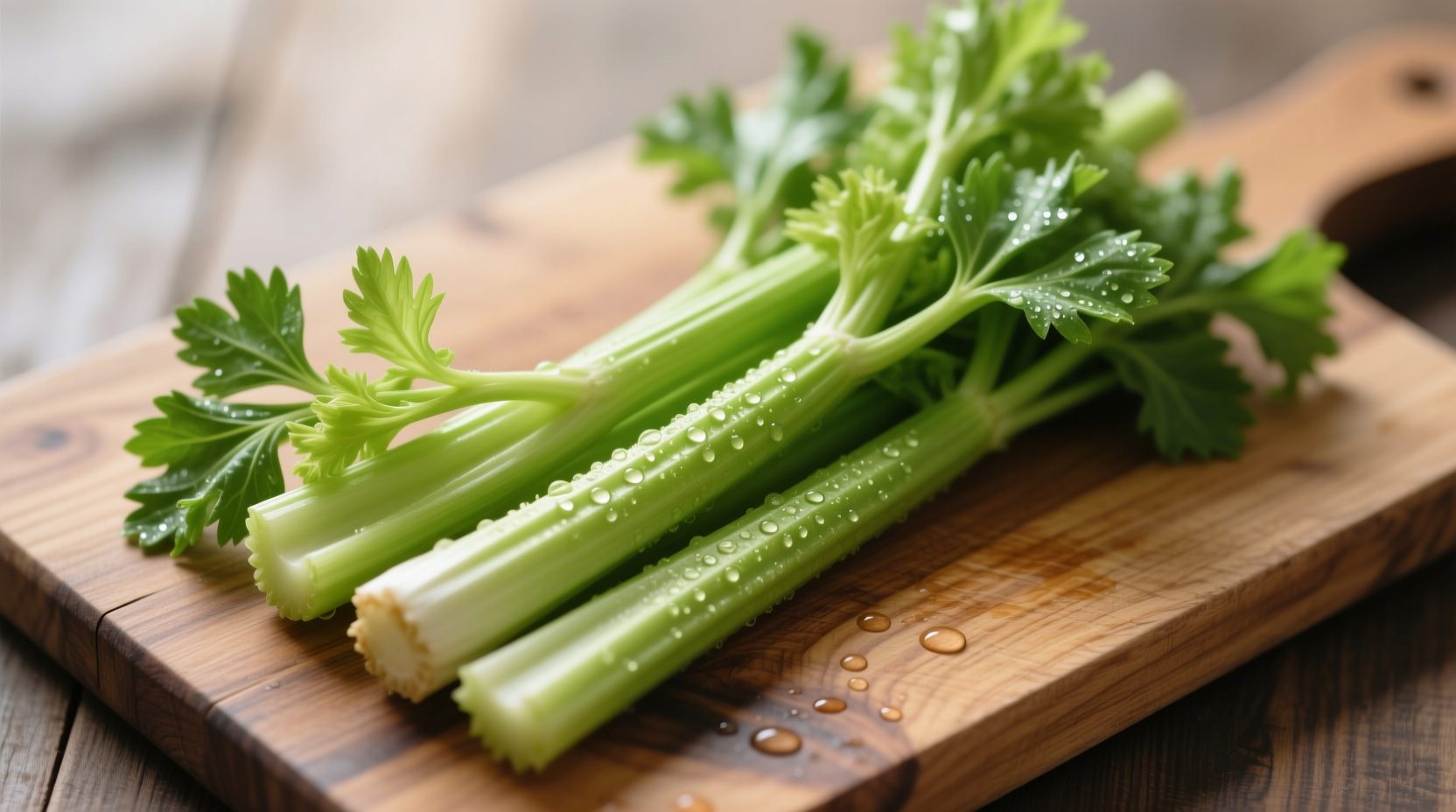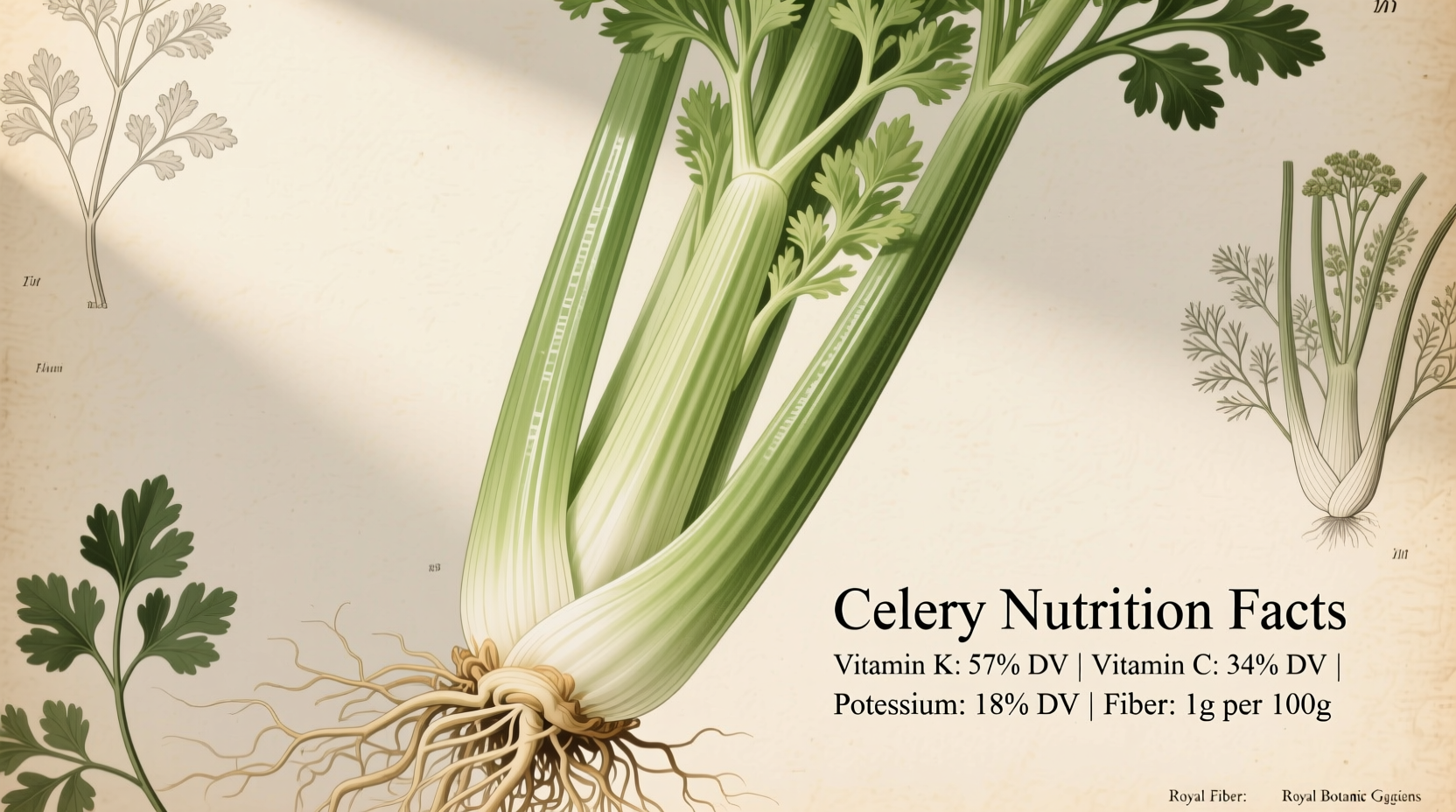One cup (101g) of chopped celery contains just 16 calories, 0.4g protein, 3.5g carbohydrates, 1.6g fiber, and delivers 14% of your daily vitamin K needs. This crunchy vegetable is 95% water, making it an excellent hydrating food with notable potassium and vitamin A content.
Why Celery Deserves a Spot in Your Daily Diet
When you're searching for celery nutrition info, you're likely looking for more than just basic numbers. You want to understand how this humble vegetable contributes to your overall health and whether it's worth incorporating into your meals. As someone who's worked with ingredients at both Michelin-starred restaurants and home kitchens, I can tell you that celery's nutritional profile punches far above its caloric weight.
Celery's Core Nutritional Profile: What the Numbers Really Mean
Understanding celery's nutrition facts requires looking beyond the basic calorie count. Let's break down what makes this vegetable nutritionally unique:
| Nutrient | Amount per 1 cup (101g) | % Daily Value |
|---|---|---|
| Calories | 16 | 1% |
| Total Fat | 0.2g | 0% |
| Sodium | 80mg | 3% |
| Total Carbohydrate | 3.5g | 1% |
| Dietary Fiber | 1.6g | 6% |
| Sugars | 1.3g | - |
| Protein | 0.4g | 1% |
| Vitamin K | 30mcg | 25% |
| Vitamin A | 453IU | 9% |
| Potassium | 260mg | 7% |
| Folate | 36mcg | 9% |
Data source: USDA FoodData Central
Hydration Powerhouse You Never Knew You Needed
With 95% water content, celery is one of nature's most effective hydrating foods. This makes it particularly valuable for athletes and those living in hot climates where maintaining proper hydration is challenging. Unlike drinking water alone, celery provides electrolytes like potassium that help your body retain fluids more effectively.

Science-Backed Health Benefits Beyond Basic Nutrition
Research shows celery contains unique compounds that contribute to health in ways most people don't realize:
Anti-Inflammatory Properties
Celery contains luteolin and apigenin, flavonoids with demonstrated anti-inflammatory effects. According to a 2020 review published in Nutrients, these compounds may help reduce inflammation markers in the body, potentially benefiting those with chronic inflammatory conditions.
Cardiovascular Support
The potassium content in celery (260mg per cup) contributes to healthy blood pressure regulation. The American Heart Association recommends potassium-rich foods as part of a heart-healthy diet, noting that adequate potassium intake can counteract some of sodium's negative effects on blood pressure.
Digestive Health Benefits
With 1.6g of fiber per cup (6% of daily needs), celery supports healthy digestion. The insoluble fiber in celery adds bulk to stool, while its soluble fiber feeds beneficial gut bacteria. Research from the National Institutes of Health shows that dietary fiber from vegetables like celery can improve gut microbiome diversity.
Celery vs. Other Common Vegetables: Where It Stands Out
Understanding celery's nutritional value requires context. Here's how it compares to other popular vegetables:
| Nutrient | Celery (1 cup) | Cucumber (1 cup) | Carrots (1 cup) | Spinach (1 cup) |
|---|---|---|---|---|
| Calories | 16 | 16 | 52 | 7 |
| Vitamin K | 25% | 14% | 16% | 121% |
| Vitamin A | 9% | 1% | 214% | 56% |
| Potassium | 7% | 4% | 11% | 16% |
| Fiber | 6% | 2% | 14% | 5% |
While celery doesn't match spinach's vitamin density, it offers a unique combination of hydration, moderate fiber, and specific phytonutrients that make it valuable in its own right. Unlike carrots, it's extremely low in natural sugars, making it ideal for those monitoring carbohydrate intake.
Practical Ways to Maximize Celery's Nutritional Benefits
Many people discard celery leaves, not realizing they contain significantly higher concentrations of nutrients than the stalks. Here's how to get the most from your celery:
- Keep the leaves: Celery leaves contain up to 300% more vitamin C and 50% more calcium than the stalks. Chop and use them like parsley in salads, soups, and sauces.
- Eat it raw: Cooking reduces some of celery's beneficial compounds. For maximum nutrient retention, enjoy it raw in salads or as a snack with hummus.
- Pair with healthy fats: The fat-soluble vitamins in celery (A, K, E) are better absorbed when consumed with healthy fats like olive oil or avocado.
- Store properly: Keep celery in the crisper drawer wrapped in aluminum foil to maintain crispness and nutrient content for up to 3 weeks.
When Celery Might Not Be Your Best Choice
While celery is generally safe for most people, certain situations warrant caution:
- For those on blood thinners: Celery's vitamin K content (25% DV per cup) can interfere with medications like warfarin. Consistency in intake is key - sudden increases or decreases can affect medication efficacy.
- People with celery allergy: Though uncommon, celery allergy affects approximately 0.1-0.4% of the population, particularly in Europe. Symptoms can range from mild oral allergy syndrome to severe anaphylaxis.
- Those with kidney issues: While celery's potassium content is moderate, those with advanced kidney disease may need to monitor intake as directed by their healthcare provider.
Putting Celery Nutrition Into Perspective
Celery shouldn't be your sole vegetable source due to its relatively modest nutrient density compared to leafy greens or cruciferous vegetables. However, its unique combination of hydration, specific phytonutrients, and versatility makes it a valuable component of a balanced diet. Think of celery as a supporting player that enhances both flavor and nutrition in your meals rather than a nutritional powerhouse on its own.
For optimal health, incorporate celery as part of a diverse vegetable intake that includes darker leafy greens, colorful bell peppers, and cruciferous vegetables like broccoli. This approach ensures you're getting a broad spectrum of nutrients rather than focusing on any single vegetable's profile.











 浙公网安备
33010002000092号
浙公网安备
33010002000092号 浙B2-20120091-4
浙B2-20120091-4